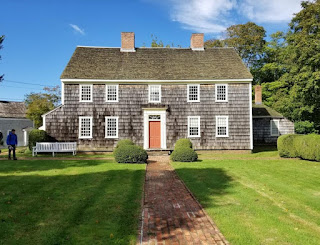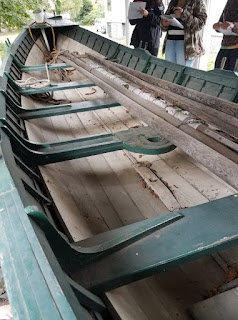Sag Harbor
by Emily Richters
The Custom House belonged to Henry Packer Dering, who was appointed Custom Master/Collector of Port by President Washington in 1790. He served for 32 years. A custom master is someone who collects all the taxes on imports coming into the country from all over the world. Sag harbor was a very busy port at the time. The Federal Government did not provide an office for him, so he would operate in his own home.
This is found in the pantry of the Custom House. It is a lovely jar of peaches. It has only been sitting and fermenting since the 1840’s. Peach wine, anyone?
Found upstairs in one of the girl’s rooms. The children would sometimes like to keep a pet in the house. The big black cage on the floor is where a child would keep a pet squirrel. Squirrels were obtained as babies, and were taken care of by the children. The smaller cage on the bed is where a pet mouse would have been kept.
The big round pan located on the bottom right hand corner is called exactly what it looks like, a Hat Tub. Much smaller than a modern day bath tub, hat tubs had a similar purpose. Water was heated over the fire and poured into the tub. The family would consecutively take turns sponge-bathing themselves, starting with the father, mother, oldest child, and then the baby. Yes, they all shared the same water.
To Catch a Whale
by Delphine Mossman
Whaling is a fairly old profession, predating European contact with the New World, but it was the Europeans who turned it into a commercial and profitable venture. Part of this had to do with the development of ships that could stay out at sea for months or even years at a time, processing each captured whale down to oil, bone, and teeth. Another major part was the development of specialized tools to capture, kill, and refine the whale carcass. The tool that underwent the most change over the decades that whaling was in its heyday was the harpoon.
Harpoons through the years. From left to right: a two flue iron, a single flue iron, a grommet iron, a temple toggle iron, and two improved toggle irons, one closed and one open to 90 degrees. Picture taken at the Sag Harbor Whaling Museum in Sag Harbor.
When a whale was spotted, a smaller boat holding six men was launched in order to try and harpoon it. A harpoon was not meant to kill the whale; rather, the goal was to attach the small boat to the whale and ride along until it tired itself out. Only then was a lance used to strike through the skin, blubber, and muscle of the whale to attempt to pierce the whale’s heart or lungs, killing it. Only after the whale was well and truly dead could it be towed back to the main boat and processed.
One of the worst things to happen to a whaler would be if the harpoon did not stick in the whale as it thrashed and ran, allowing it to escape the smaller boat. As a result, the design of the harpoon was refined to attempt to make one that would stick in the whale no matter what. The eventual result of this evolution can be seen on the far right of the picture above. The head of the harpoon would be held against the shaft by a small piece of wood. When the harpoon entered the whale, the wood would snap, and the pulling of the whale on the harpoon would cause the head to rotate and form a right angle with the shaft. This greatly lessened the chances of the harpoon sliding out of the wound, and these harpoons were used for hunting whales by hand until the end of whaling.
Whaling techniques
by Amanda Ackermann
Whaling was one of the most important industries in coastal communities in Long Island. As time went on, whaling changed and evolved. Shore whaling was the original form of whaling in Long Island for settlers, with whalers mainly hunting Right Whales and the occasional Humpback. Native Americans often scavenged beached whales, but also built canoes to try and herd whales that were close to shore towards the beach, using loud noises to scare them inward. As whales became more scarce along the shore, deep water whaling became the primary method of harvesting whales. Below is an image of a typical boat used for shore whaling.
This seemingly small boat was stable enough to withstand being towed by a whale the size of a school bus, and could hold all the necessary equipment and people needed for the hunt. Its versatility allowed both ends to be used as the stern or bow, with the knob at the end seen in the picture as the place where the harpoon was tied off to. It would be the job of the boatheader to command the boat from where he stood at the stern. The boatsteerer would harpoon the whale when they were close enough. The rope would then uncoil rapidly, and the crew had to make sure to dowse it whenever it began to smoke. Once the whale was close enough, the boatheader would switch places with the boatsteerer (a dangerous procedure) and use the lance to kill the whale.
Whaling was a largely communal effort, with everyone in a town having a part in the business. This (slightly blurry) image depicts a typical scene from an algonquin tribe after a successful shore whaling hunt (or if they were lucky, a beached whale). Once the whale was on land, the processing would begin right away. The skin was stripped off of the whale, and the blubber was placed into large vats where it would be boiled (seen on the far right). This was a job usually left for women and those not young enough to hunt whales yet. Those impurities left over from the oil boiling would be used as fertilizer.
This image is of a whale vessel that would have been used in the 19th century, when shore whaling was no longer successful. These ventures would take the men out into the Pacific Ocean, where they could spend months to years trying to fill up the cargo hold with whale oil. There were six whaling boats attached to the ship, so when a whale was spotted the hunters would go into the smaller boats to pursue the whale. Once the whale was killed, the boats would tow the whale in towards the ship, where it would be chained up to the starboard side. It was then that the rest of the crew would quickly begin processing the whale, in a dangerous setting of sharp knives and a slippery deck. The head of the whale was most valuable, as it contained large amounts of oil, and they were able to remove the teeth and use it as scrimshaw to pass the time aboard. Whale oil would be boiled in tripots right on the ship, despite the danger. Waiting until they reach shore could risk spoiling, and the whalers wanted to make as much of a profit as they were able
Custom House
by Stephen Havens
The Custom House, in Sag Harbor was the house of custom master Henry Packer Dering. The custom master oversaw the collecting and enforcing of import taxes on shipments coming through the port of Sag Harbor. There were many interesting things in the custom house that revealed things about the way of life in the late 18th and early 19th centuries. All photographs used are credited to the Custom House Museum in Sag Harbor.
This was a bed, located on one of the children’s rooms in the Custom House. It had rope stretched across the bedframe instead of springs, and each evening before bed needed to be tightened with the wooden instrument on the foot of the bed.
This was known as a “Pie Safe”. Constructed of thin wire mesh, it was where recently baked breads and pies would be placed to cool off. Cheeses were also stored here. The thin wire mesh would keep bugs off the baked goods, and a lock was even present to keep out the hungry kids.
Pictured here is a fruit press
and a popcorn and waffle maker
Fruits would be placed inside the device and the handles would be pressed down, squeezing the fruit allowing for juice to be produced. The waffle and popcorn makers had long handles so that they could be safely held over the fire while being used, as there were no stoves during this time period.
Daily Customs
by Adam Dean
Upon visiting the Custom House I was able to see that there are many items that were used back then, that we either don’t use now, or are altered in function. An example of something humans no longer use (but perhaps would have an equivalent modern market for) are the bed warmers of the day. Families in that day would often put hot coals in a metal bed warmer, and place the bed warmer within the sheets, to preheat the bed for the occupant. The closest thing I can think of to this in the modern day would be a heat blanket, although I’d argue most people don’t use them to preheat the bed.
On the topic of outdated everyday items, I would also like to talk about the idea of a pie safe. Most noteworthy people of the early 1800’s had a pie safe, which was almost like a breadbox in the shape of a chicken coop- raised off the ground, with wire mesh to keep out rodents, and of course with a lock to keep out children. Another interesting locked item of the day included clothing chests, which today would be unusual- although for some reason it made perfect sense, possibly because of the cost of nice clothing at the time. Other everyday clothing items included hats and canes. Nobody, not even children would be seen outside the home without a hat on in this time period, and the well to do almost always carried a cane or walking stick- something which is mostly reserved for those who need the assistance walking today.
Typical bedrooms of the day were separate, husbands and wives had their own sleeping quarters if they could afford it. Many couples today would either hate this feature, or have been asking for it every day for the past five years. Pertaining again to the sleeping situation, it was not uncommon to have ropebeds, where instead of a mattress; the sleeper would lie on sheets over a web of ropes, which would be tensioned before sleeping. Other bedroom anomalies include a bootjack, which is relatively equivalent in function to a modern day shoehorn- although instead of helping you hold back the lip of the shoe, a bootjack holds the boot in place as you cram your foot inside it. The shoes you put on would also be similar to those of today, although they would not be specific to your right and left foot, they would be completely identical. Lastly, on your dresser would often be a bloodletting tool- seeing as “releasing bad humor” from your body was seen as one of the most helpful and widely used home remedies for disease.
In short, many home items of the 1800’s serve a different purpose now, or have become obsolete. However, it can be very intriguing to see where some of your home appliances and everyday items come from. Who would’ve taken the time to think about how annoying it must have been to make toast back then, and appreciate not having to hold your bread on a fancy stick in front of a fire in the morning.















